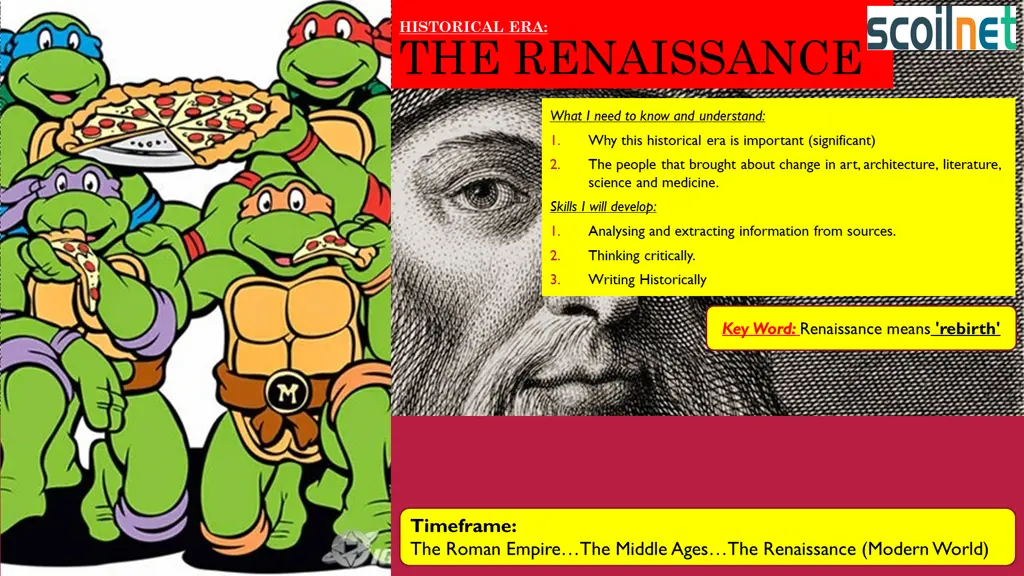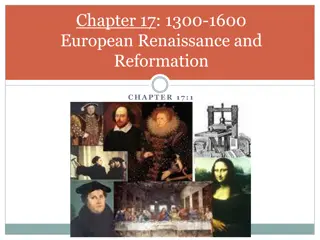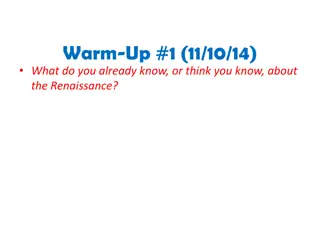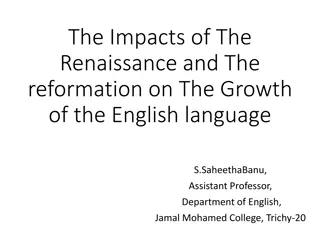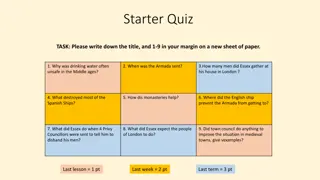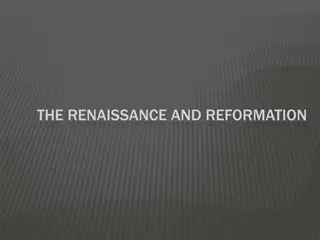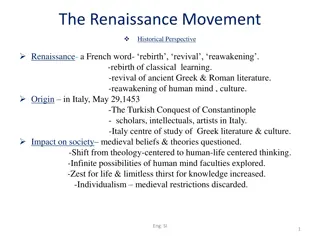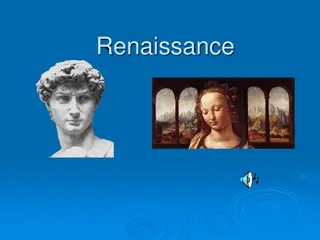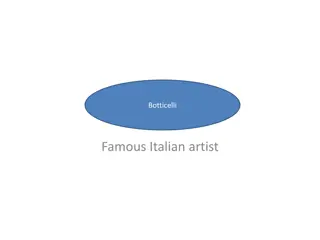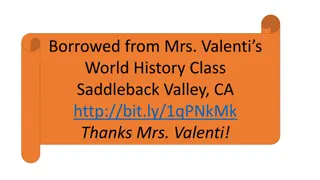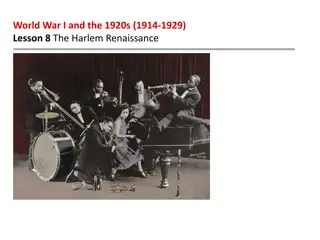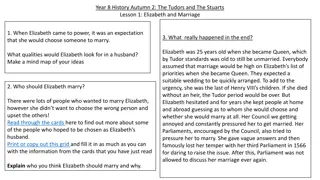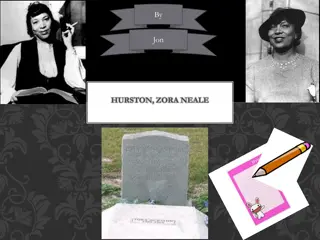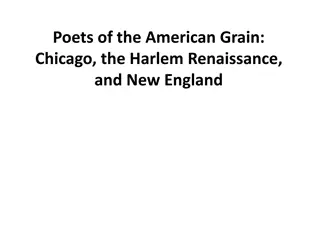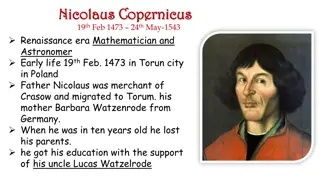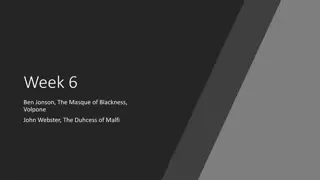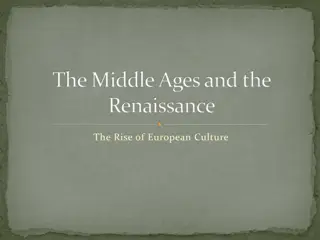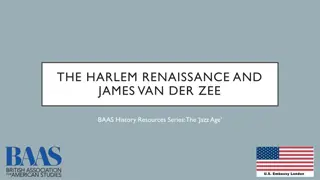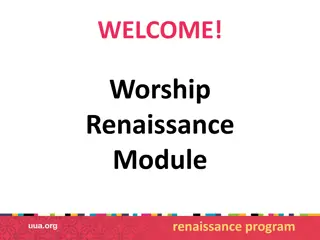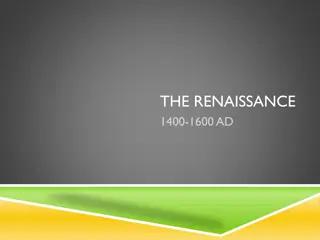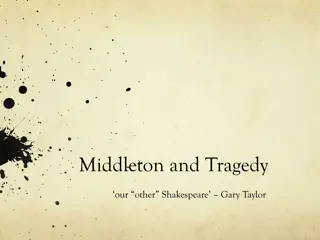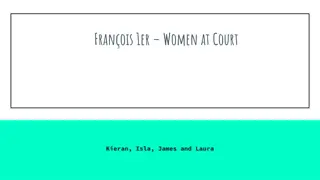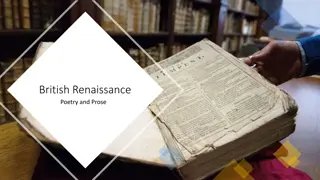The Renaissance
The significance of the Renaissance historical era and the people who revolutionized art, architecture, literature, and science. Develop skills in analyzing historical sources, critical thinking, and writing.
Download Presentation

Please find below an Image/Link to download the presentation.
The content on the website is provided AS IS for your information and personal use only. It may not be sold, licensed, or shared on other websites without obtaining consent from the author. Download presentation by click this link. If you encounter any issues during the download, it is possible that the publisher has removed the file from their server.
E N D
Presentation Transcript
HISTORICAL ERA: THE RENAISSANCE What I need to know and understand: 1. Why this historical era is important (significant) 2. The people that brought about change in art, architecture, literature, science and medicine. Skills I will develop: 1. Analysing and extracting information from sources. 2. Thinking critically. 3. Writing Historically Key Word: Renaissance means 'rebirth' Timeframe: The Roman Empire The Middle Ages The Renaissance (Modern World)
Thinking Cap: From this picture, why do you think the Renaissance started in Italy? Let s discuss. Firstly, The Renaissance began in Italy 1. Italy was the crossroads of the world. People from different countries passed through regularly with new ideas. Intelligent people from Greece fled to Italy during an invasion in their own country. They brought new ideas. There was a lot of rich people in Italy; they supported people bringing about change in art, architecture, etc. They were called patrons. A famous patron was Lorenzo de Medici. People in Italy were surrounded by the creation of the Roman Empire, this inspired them. Can you name any famous remains? 2. 3. Lorenzo de Medici 4. Key Word: Patron a person that financially supports the arts
CHANGES THAT TOOK PLACE IN ARCHITECTURE GOTHIC MEDIEVAL STYLE ROMANESQUE STYLE Pair work: Identify and explain three features of each style.
CHANGES THAT TOOK PLACE IN ARCHITECTURE Possible Answers: Gothic Pointed arches Rose Window Pointed Door Spire Possible Answers: Romanesque: Classical columns Rounded Window Dome Homework: Narrative engagement Read about changes in architecture in your textbook.
CHANGES IN ART MEDIEVAL ART RENAISSANCE ART Pair work: Identify and explain three features of each style. Raphael s The Marriage of the Virgin Cimabue s Madonna Enthroned
CHANGES IN ART Medieval Art features: 2D no depth or background Colours were dull or dark People did not look realistic. Their size in the picture depended on their status. Main themes were Christianity Artists used egg yolk. It dried quickly, therefore difficult to correct mistakes. Renaissance Art features: Artists used perspective to create an illusion of depth (background) (3D) Colours were bright Vibrancy Used a technique called sfumato to make people look real. Some artists studied the human body to perfect their work. This is called anatomy. Artists used Linseed oil. It dried slowly, allowing the artist to correct mistakes. Homework: Revise the changes in art. Literacy preview: Read about da Vinci in your textbook.
RETRIEVAL TASK: CHANGES IN ART Lesson 3: What s the keyword? Read through the definitions below and try figure out what the key word is. Key Word Definition A technique to make people look more life-like. A liquid used to allow paint to dry slowly so artists could correct mistakes. What the painting is representing/what it is about. Bright colours are used to create this. A technique used to create an illusion of depth (background) A movement in art that aimed to make the painting to appear real.
Creating Timelines 'The 'The Renaissance Renaissance Man Man' LEONARDO DA VINCI LEONARDO DA VINCI Create a timeline of Create a timeline of Leonadro Leonadro Da Vinci s Life Da Vinci s Life 1. Class discussion: has anyone any knowledge of this person? 2. Pair-work: Research the life of Leonardo Da Vinci using your textbook or device. 3. Divide areas of your research up between you. 4. Together map his life from birth to death, identifying all major milestones in between. 5. Find out what he studied to improve his paintings and his other interests and achievements. 6. After you complete your timeline; watch the clip below to reinforce learning. Draw your timeline like the one below: Watch this clip about his life: https://www.youtube.com/watch?v=Rm0qszPJnc8
FAMOUS ARTWORK: Thinking critically: What feature of the School of Athens is evidence that it is from the Renaissance era? Raphael Michelangelo Thinking Critically: What feature of the Statue of David is evidence that it is from the Renaissance era? 'The artist that surpasses them all' Research Michelangelo and make note of 2 contributions he made to the Renaissance era.
Lesson 4: THE PRINTING PRESS & RENAISSANCE LITERATURE Literacy: Key Words: Note: Before the Renaissance books were written in Latin. Vernacular the language spoken by people in their native country Humanism - to focus on humans, rather than God.To learn from human experience, rather than follow religious instruction Famous Renaissance writers: - Shakespeare (English) - Erasmus (Dutch) The printing press was invented by Johannes Gutenberg in Germany in 1450 Critical thinking: Why might this have been considered the greatest invention of all time? Literacy Tasks: 1. Create a sentence with the word's vernacular and humanism 2. Read about the printing press in your textbook 3. Source Question
CHANGES IN SCIENCE & MEDICINE Literacy: Key words: Bloodletting cutting the skin to release blood Anatomy studying the body Heliocentrism the idea the sun is the centre of the universe Inquisition a court within the Catholic church Medicine Medieval Practices Herbal & ointment treatments, bloodletting, amputations & even magic. Often performed by the wise-old woman, the barber, the butcher or the priest. Science Beliefs The Church preached that the earth was the centre of the universe. Nicolas Copernicus (above) discovered the sun was the centre.He didn t publish his findings until on his deathbed. Medicine Renaissance changes A medical school was set up in Salerno, Italy. Medical textbooks began to circulate. Anatomy (studying the body) became common. Why might he have done this? Literacy Task: Read about how Galileo (left) confirmed Copernicus' discovery and published his findings. Write a paragraph on this topic. Refer to: discoveries, instruments, punishment, outcome Research task: Investigate Person Contribution to medicine Andreas Vesalius William Harvey
TO CONCLUDE... Writing task: Discuss the following statement with a classmate and write an account on this statement. The Renaissance began a profound questioning spirit among people in Europe and this resulted in a lot of change which makes this historical era so important. Don t forget to mention! Refer to: 1. Architecture What the Renaissance period encouraged people to do! 2. Art 3. Science What did it lead to? 4. Medicine 5. Literature What powerful organisation was not happy! And why? 6. The remarkable impact of the printing press. Writing historically: 1. Avoid opinion, e.g I think 2. Don t use the pronouns I , We 3. Keep it factual
